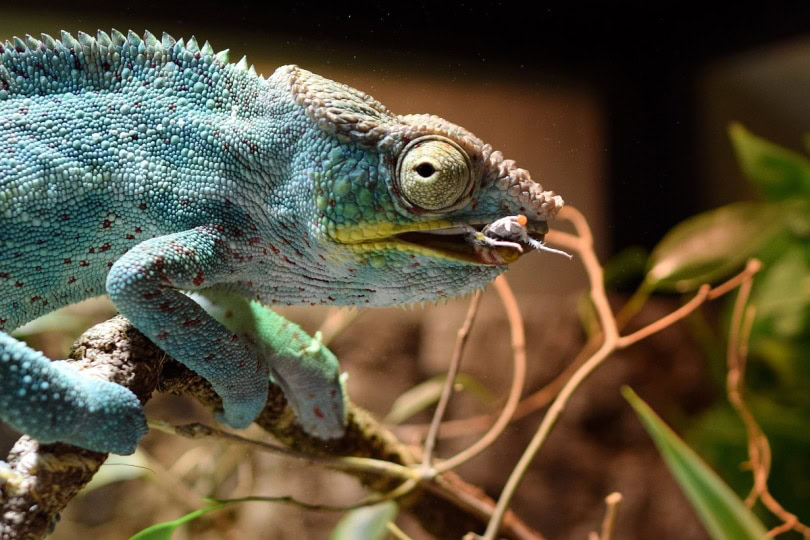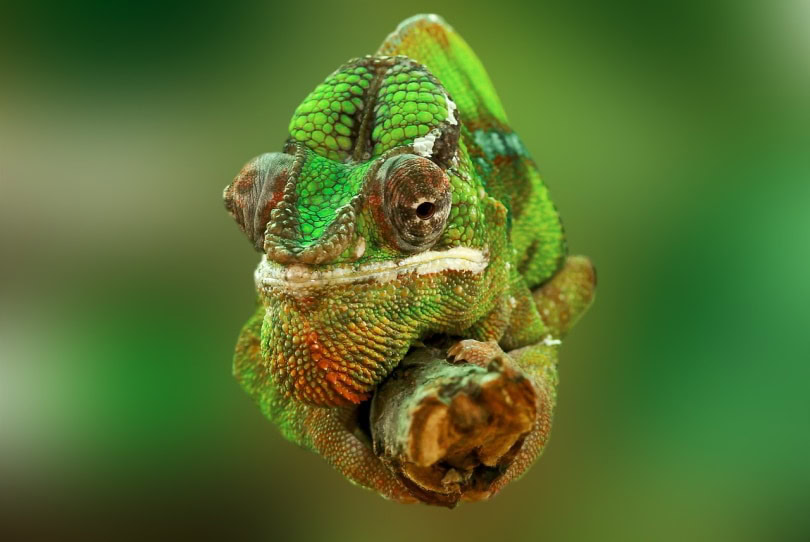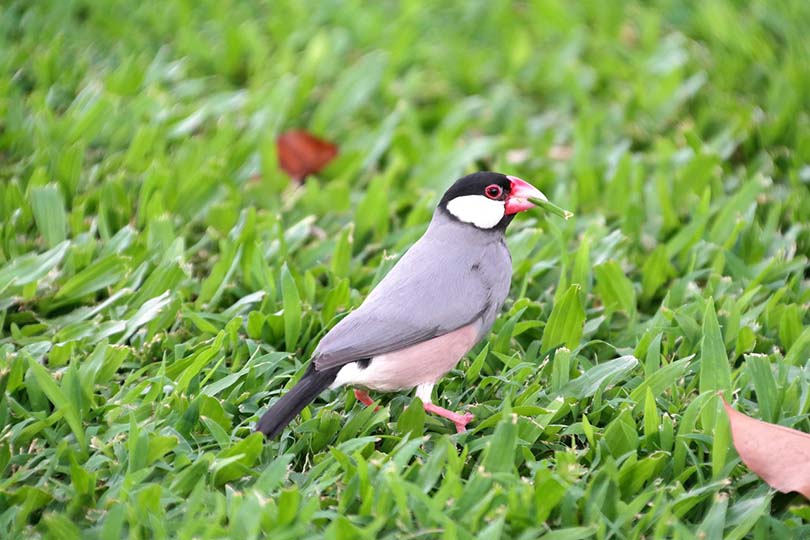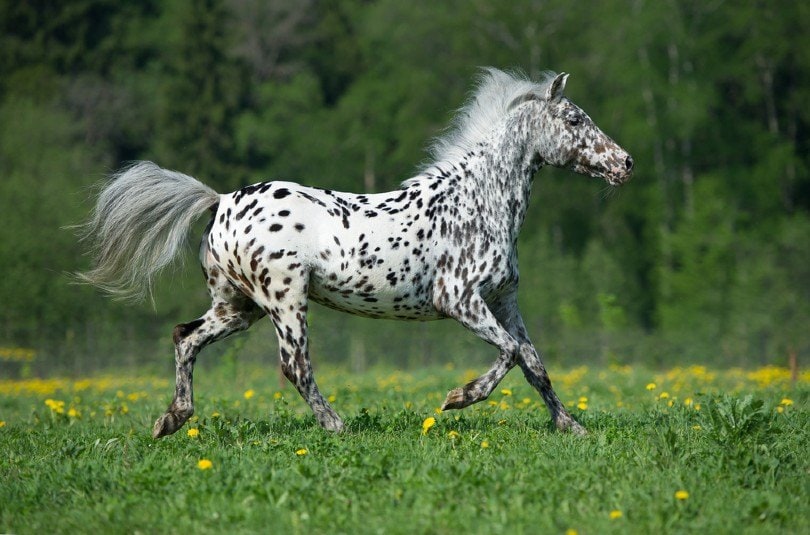Click to Skip Ahead
A Rudis Chameleon is a very interesting type of chameleon that comes from the island of Madagascar. You can find them in the wild, but they are also bred in captivity. These chameleons have a unique look due to their red coloration and their oddly shaped horns.
If you want to care for one as a pet, make sure to follow these steps so that your little friend will be healthy and happy!

Quick Facts about Rudis Chameleon
| Species Name: | T. Rudis |
| Common Name: | Rudis Chameleon |
| Care Level: | Intermediate |
| Lifespan: | 3 – 4 years |
| Adult Size: | 5 – 7 inches |
| Diet: | Crickets, hissing cockroaches, mealworms, waxworms, silkworms, hornworms, and tomato worms |
| Minimum Tank Size: | 30 gallons |
| Temperature & Humidity: | 65 – 70 °F (cool side) to 80°F (basking spot) |

Do Rudis Chameleon Make Good Pets?
Rudis Chameleons are still fairly uncommon as pets, but they can make wonderful companions. They’re not the most common pet chameleon out there, though they might be one of the best chameleons to have if you like an active and sociable type of animal that likes to climb around a lot.
The Rudis Chameleon is a great starter chameleon, and it’s also an ideal pet for kids. They’re hardy creatures, but they do need a bit more attention than the commonly sold veiled or panther chameleons.
Appearance
The Rudis Chameleon is an arboreal chameleon that typically resides in leafy trees. The color of the skin varies, with many being green but also blue and red. They can be identified by their long tail, which they use to balance rough surfaces and tree branches.
There are a few different types of Rudis Chameleon, with the most popular being the Red-Tail. This species is also known as the red tail chamaeleon, and it comes from East Africa in regions like Rwanda, Ethiopia, Somalia, and Kenya. They are often seen hanging out on tree branches with many leaves because this way, they can blend in.
When they feel threatened, the Rudis Chameleon will look down and exposes their red underside as a form of defense mechanism in an attempt to scare off predators. If this doesn’t work, then it is likely that they’ll try to get away by leaping from one tree branch to another or by jumping on the ground.

How to Take Care of Rudis Chameleon
Rudis Chameleons are fairly easy to take care of, especially if you have experience taking care of other types of chameleons.
Tank
Rudis Chameleons naturally live in humid, tropical environments. They are native to the dense rain forests of Madagascar and enjoy high perches for safety and plenty of plants to eat from on their tree trunks or branches.
The enclosure should be at least 30 gallons to provide enough space for this type of chameleon.
Cleaning and Maintenance of the Tank
The tank should be cleaned by a professional once every three months, and the substrate replaced with new fresh sand. When cleaning the aquarium, they can use water vacuum cleaners as needed to remove any loose debris or waste present on top of the soil. They can also rinse out live plants to prevent them from getting infected with fungus or pests. They should also replace the filter media inside of your aquarium every six months to maintain the tank’s water quality. The substrate and live plants can be removed when cleaning, then replaced after a thorough rinse.
Lighting
They require a daytime light bulb that’s on for 12 hours each day and can get by with your home’s humidity levels.
Heating (Temperature & Humidity)
They should be kept at a temperature of 75 degrees Fahrenheit, with nighttime temperatures dropping to about 65 degrees. Humidity levels should be in the 60% range or higher if possible, but they can get by nicely without it (as long as your home isn’t dry).
Substrate
You can use many different materials as a substrate for your pet’s enclosure, but most people like to use sand because it is effortless to clean, inexpensive, and natural.
Tank Recommendations
| Tank Type: | 30 gallon glass vivarium |
| Lighting: | Basking light |
| Heating: | Heating pad/tape on bottom of enclosure |
| Best Substrate: | Sand |

Feeding Your Rudis Chameleon

A Rudis Chameleon is a medium-sized lizard, so they will need to consume large amounts of proteins. A homemade diet could consist of protein powder blended with fruits, vegetables, and other foods high in nutrients, such as eggs or meat (beef liver). As an example: mix 50% fruit with 25% vegetables or eggs. Blend in 25% protein powder with water and feed the mixture to your chameleon once a day, at least twice per week.
The Rudis Chameleon needs calcium for their skeleton as well; it should be provided by feeding them mealworms and crickets (both are high in calcium). You can also offer them various other food items, such as watermelon, apples, bananas, and almonds. Offer your chameleon an assortment of fresh fruits and vegetables to choose from (this will help their digestive system).
Diet Summary
| Fruits: | 25 % of diet |
| Protein: | 50 % of diet |
| Supplements: | 23% of diet |
Keeping Your Rudis Chameleon Healthy
The Rudis Chameleon is a hardy species that does not undergo much change in appearance or health.
Common Health Issues
The most common causes of illness among the Rudis Chameleons are stress-related illnesses and dehydration, which can be avoided by providing them with an appropriate environment and ensuring they have access to water at all times. Other potential causes of illness can include bacterial infections, parasitic infections, and malnutrition.
Some other potential causes of illness include bacterial infections, parasitic infections, and malnutrition
Lifespan
The Rudis Chameleon has a lifespan of around 3 to 4 years.
Breeding
Breeding can be a reasonably easy task to accomplish. If you are interested in mating them, their cages need to have an area with sufficient height for egg-laying and nesting. That means they must have appropriate climbing areas and taller plants for the female to lay her eggs in.
One male per four females is a good rule of thumb when breeding chameleons, but you can do more if desired. Males will fight for dominance, and this may lead to injury or death. Females are much less aggressive with one another, so it’s not necessary to have more than two females per male. One of the more than 300 species of chameleon, different variables can cause a female to become ready to breed. In some cases, females may change their coloration and turn aggressive, but this is not always an accurate indicator. Before starting breeding for the first time, you should research your particular animal’s breed before beginning.

Are Rudis Chameleons Friendly? Our Handling Advice
Rudis Chameleons are usually friendly and docile, but they can be defensive when threatened. They will generally go as far as to appear aggressive if necessary. When in danger or startled, Rudis Chameleons might display an arched back with their spiky tail sticking up and a flared-out crest on the head.
The Rudis Chameleon is a social creature that needs to be handled gently and regularly from the hatchling stage onward to keep them docile. They have an exciting temperament that varies on the individual chameleon, but they do not generally like handling humans or other animals if they are not used to it early enough.
When handled regularly from the hatchling stage, Rudis Chameleons are generally calm and docile. They might grip on objects with their claws when they feel threatened, but this is merely a defensive reaction. If you keep your chameleon in captivity for most of its life without handling it or being around them often enough, it could result in an aggressive chameleon.
How Much Do Rudis Chameleon Cost?
The cost of Rudis Chameleon is based on size and age. One-year-old Rudis Chameleons range from $50-$299, while one-month-old Rudis Chameleons start at around $50. There are dozens of variables that affect the price tag for a Rudis, such as size, age, and location. You can find Rudis Chameleons in many pet stores and popular online marketplaces.
Rudis Chameleons Pros & Cons
- Independent
- Clean
- Quiet
- Hard to Handle
- Tricky diet for first-timers
- Short Lifespan

Summary
Rudis Chameleon is an excellent pet for people who have experience with exotic animals and are committed to providing the proper care. They are ideal for those looking to get their first chameleon or add another species of reptile to their collection. With proper care, your Rudis Chameleon can live for several years and become a short-term member of your family!
If you have any questions or comments, please feel free to ask us! We love talking about all things animals.
Featured Image Credit: FrankWinkler, Pixabay










